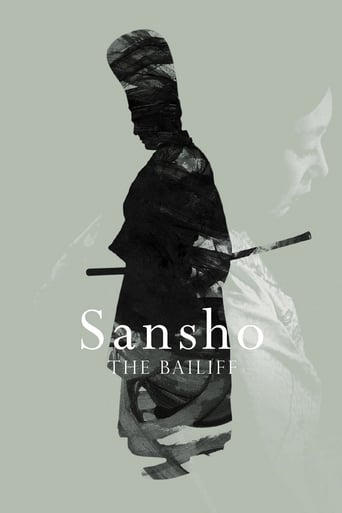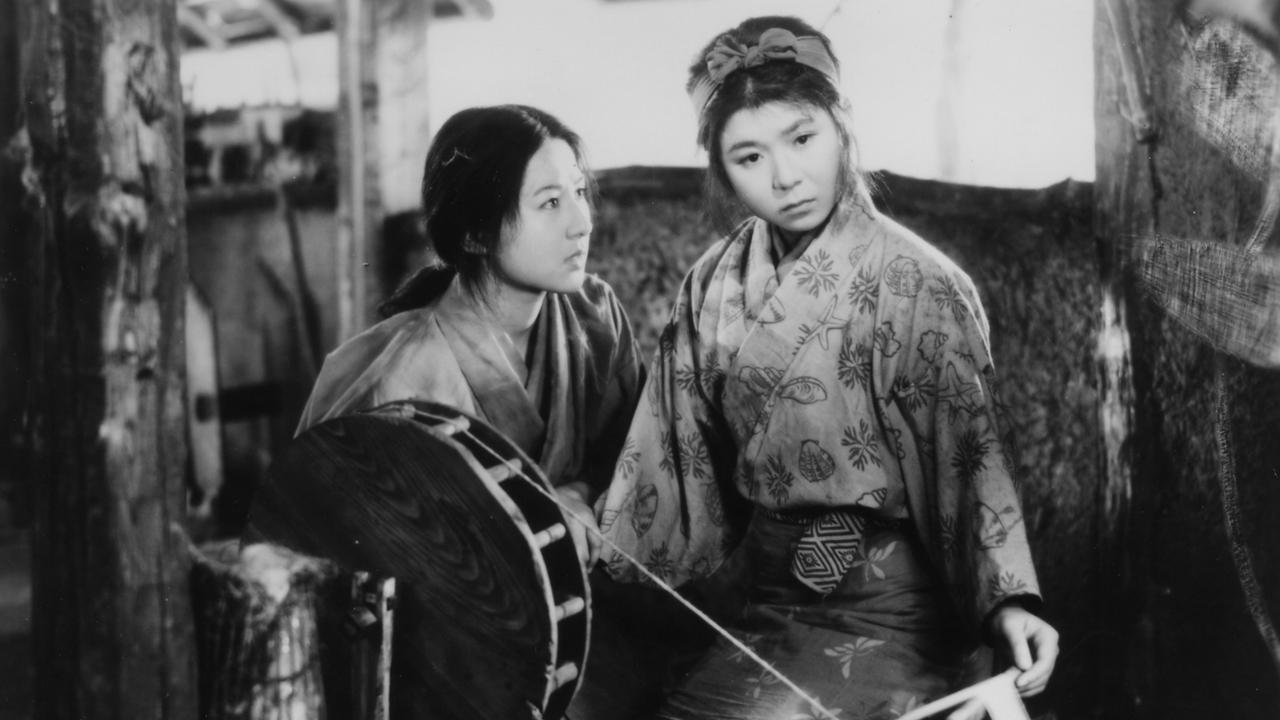JP_Shay
A family torn apart during the oppression of medieval Japan struggles to survive and reunite in this powerful film by Kenji Mizoguchi. What makes "Sansho The Bailiff" so powerful is the bond between the brother and sister who were sold as slave workers at an early age, and the hardships they endure over the years. The mother was sold separately as a prostitute and longs for the return of her children. Though, the distance between them is large, they are bonded by love and an everlasting drive to reunite. I would be lying if I said this is not a dark film. This is a very dark film but underneath the darkness lies a perpetual beauty. I was genuinely in awe of the cinematography of this film. This is definitely one of the finest looking films ever. From beginning to end, every single frame is a work of art and brings color to the black and white. One scene that comes to mind is the mother, son, daughter and servant making a shelter underneath a tree. The way the scene plays out as the camera follows the children back and forth while they happily gather brush for the fire is one of the only lighthearted moments in the film. They are unaware of where they are going but they have each other, for now. Japan is quite a magnificent land and since this film is a period piece, it was mostly shot on location and the sets/props to be as faithful to the original source as they could. I found 'Sansho' to be very sincere in that respect. The performances are all extremely good and seemed reminiscent of classical theatre, which gave it a very genuine feel. I would not be surprised if all of the actors were classically trained theatre actors. Yoshiaki Hanayagi (who plays the son "Zuchio") is the main hero of the story and he shines in the role. After a decade of living under the rule of Sansho the bailiff, Zuchio becomes complacent in his role as a slave and in his own words decides "it is better to get on the bailiff's good side than try to escape and become a beggar or bandit at best." much to the dismay of his younger sister Anju, who urges him to remember their dream of freedom and reunion. These differing perspectives lead to conflict among the pair, which is depicted in such a way that we understand both sides and never lose faith in Zuchio realizing his destiny. Kenji Mizoguchi definitely has a style of his own and utilizes it to bring to life powerful human stories. The music was composed by the great Fumio Harayake, who also worked on "Ugetsu" and many other classics. His score for "Sansho" perfectly accompanies the films atmosphere and enhances the emotions evoked. Mixed with the wonderful cinematography and brilliant storytelling, you are left with a masterful film all the way around and I recommend it to everyone who appreciates good cinema in general. I lost track of time during the 2 hour run length because the story had me so involved and caring about what happens next. This film exceeded my expectations - breathtaking and visually stunning - what a wonderful film! The ending will leave you in tears. 10/10 ps - The title may be misleading. "Sansho The Bailiff" is not actually about Sansho the bailiff. He is an important figure and the film's main "villain" so to speak, but it is ultimately about the separated family.
sharky_55
For almost the entirety of the one hundred and twenty four minutes, the characters are tiny, insignificant figures. Mizoguchi has a rigid, classical style deeply steeped in composition; the scene has already been etched in with lines and placements and blocking, so what is the use in moving the camera? This approach mimics the sedentary lives of the characters. Their menial work is confined to a square, and when they walk, it seems to be with no destination in sight at all. When the non-slaves move it is with an illusion of purpose - they seem convinced that there is something of a cause to aspire towards, and travel in nameless horde. Mizoguchi never graces them with a closeup, and in a suicidal sacrifice that would haunt even the most steady viewer, he robs even this act of its agency, and suggests that her body has the impact of little more than a stone spreading ripples through the lake's surface.So there are two truly great scenes here that shatter this apparent idyllic illusion. The first is the riot and revolution as the ex- slaves rise up and tear down their former master's mansion. Mizoguchi's crisp lines and segments are utterly demolished in fire and frenzy - the camera struggles to fully capture the extent of the chaos. This would not have happened without that teary outburst from Zushio, former slaver to former slave, freeing them from their captivity and urging them to go live their lives. It is tremendously powerful because he has been both literally and figuratively shackled for his entire life, so the emotional outpour is not only for those he addresses, but for his own release. The second is the final shot. Zushio has been told that his long lost mother has surely been reclaimed by the elements, by the recent tidal wave. This recalls Anju's death - who seemed to go willingly and of her own accord, but which Mizoguchi made so painful and inevitable with the threat of the slaver's torture. When Zushio finally reconciles with Tamaki there is an outpouring of both grief and happiness in conflict. She says that they have been pulled together by fate only because he has never wavered by his late father's two commands; to be merciful to all, because all men are born equal and entitled to happiness. And yet Mizoguchi pans away from what seems like closure...once again to the sea, which is only biding its time to once again swallow these tiny little figures. How much of this shoreline has it eroded?
Tomas_T
Sansho the Bailiff is Japanese director Kenji Mizoguchi's great contribution for film industry. The late director is remembered for his mastery of the long takes (uninterrupted shot lasting longer than conventional takes) which he uses to full effect in Sansho the Bailiff.The film tells an excruciating tale of human cruelty and compassion of two 11th-century Japanese aristrocratic children who are sold to slavery. Sounds bleak and in all fairness there is very little uplifting to say about the story. In fact the film draws its great impact from emotional turmoil and despair which the children, Anju (Kyoko Kagawa) and Zushio (Yoshiaki Hanayagi), experience during their long and miserable captivity. At a glance one might think Sansho the Bailiff was uneventful film, but the director's great skill to draw drama out of human plight quickly captivates. For such a slow paced and actionless drama film, I was truly impressed how effortlessly the film managed to keep me fully immersed with the film through the running time.For its great age, Sansho the Bailiff, has truly aged gracefully and it still witholds great emotional impact even after ~60 years since its creation. Director Kenjo Mizoguchi truly created a beautiful classic with Sansho the Bailiff and after seeing the film I now fully understand and agree with all the praise western critics and film-makers alike have given Sansho the Bailiff.
Robert J. Maxwell
After the first twenty minutes or so I wasn't expecting too much from this production, despite the cachet of the director's name. A humanistic governor of a rural Japanese village in the feudal era is sent into exile and his wife and two children must wander the roads. They run into bandits. The mother is sold into slavery on one island and her little boy and girl are slaves on another. Innumerable tribulations follow and I worried this might turn into a 1954 Japanese version of torture porn.By this time, though, I noticed a couple of interesting things about the film. One was that every shot -- and I mean every single shot -- was done with the eye of a painter. The compositions were nearly perfect.Another thing I noticed was -- well, have you ever seen one of Sergio Leone's spaghetti Westerns? Or any of their imitations? You know, the movies that are full of greasy faces in choker close ups, the bone-white teeth glistening out at you? If you have, then imagine the opposite. I only saw one close up in the entire movie, and that comes near the end when the identity of a blind, lame old woman on the beach is revealed. In the absence of close ups, even a medium shot, or a shot of someone from the waist up, is a bit of a shock.Anyone who's kept his eyes open will be familiar with the mistreatment of slaves. The forms they take seem universal. You get separated from your family, the women serve as whores, they're beaten for infractions, and if they try to run away they're branded or they have their Achilles' tendon cut.After eight years of suffering, the young boy, Zushio manages to escape from the manor of the slave owner Sansho, a Bailiff. He comes across one of those benefactors found in some stories -- "Ben Hur" or a tale by Dickens. As a result, he becomes governor of the province, frees all the slaves, arrests Sancho the Bailiff, and resigns his post in order to go in search of two slaves who had become his friends, as well as his sister and his mother. The results are mixed.When Zushio escapes, the pace of the film picks up and by the end I was thoroughly involved in the fate of the young man and his family. And that's despite the fact that this is not a Samurai movie. There is no swordplay or any genuine combat, although it could easily have fitted into the narrative.The story is rudimentary, not very complicated, and the movie is in black and white with subtitles. But this is a tragedy of the sort that is universal in its appeal. Well worth catching, as long as you have some patience during the establishing scenes.


 AD
AD



